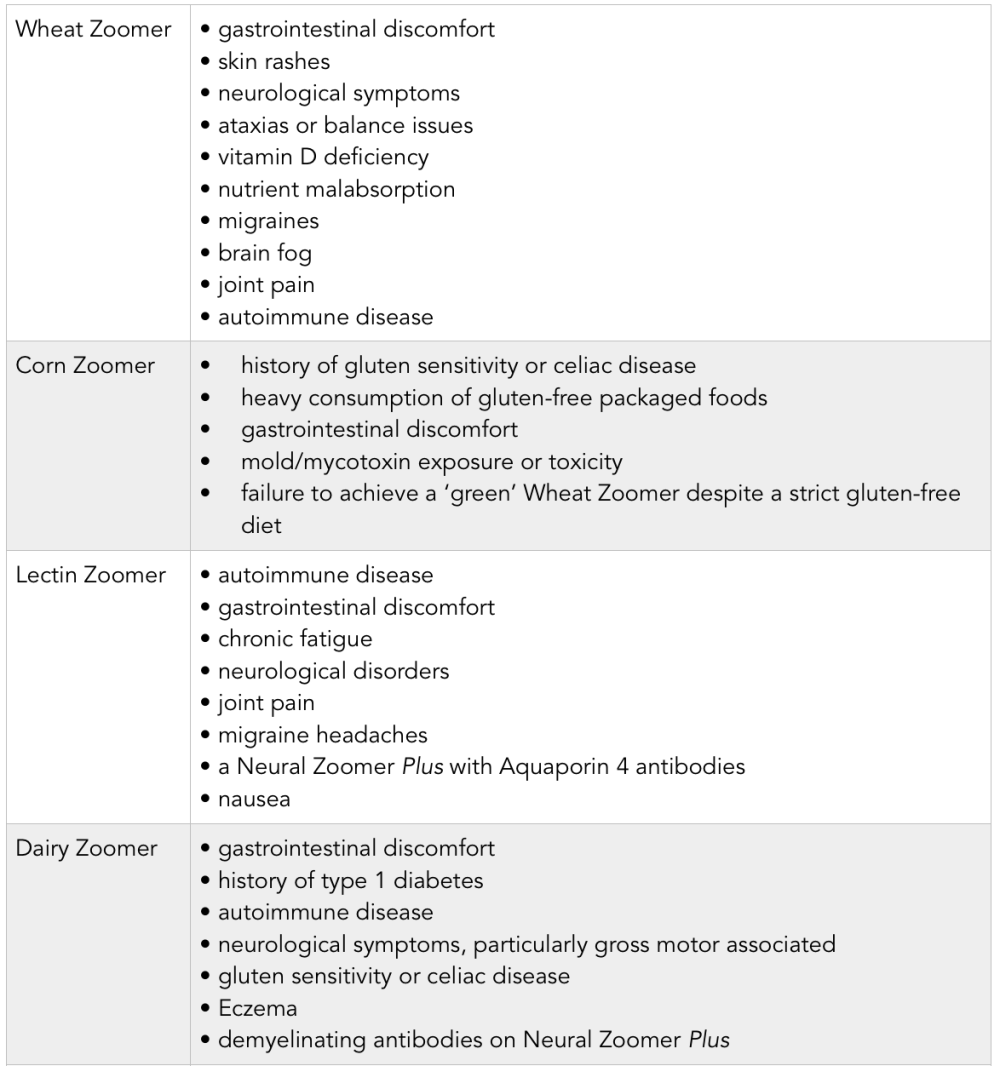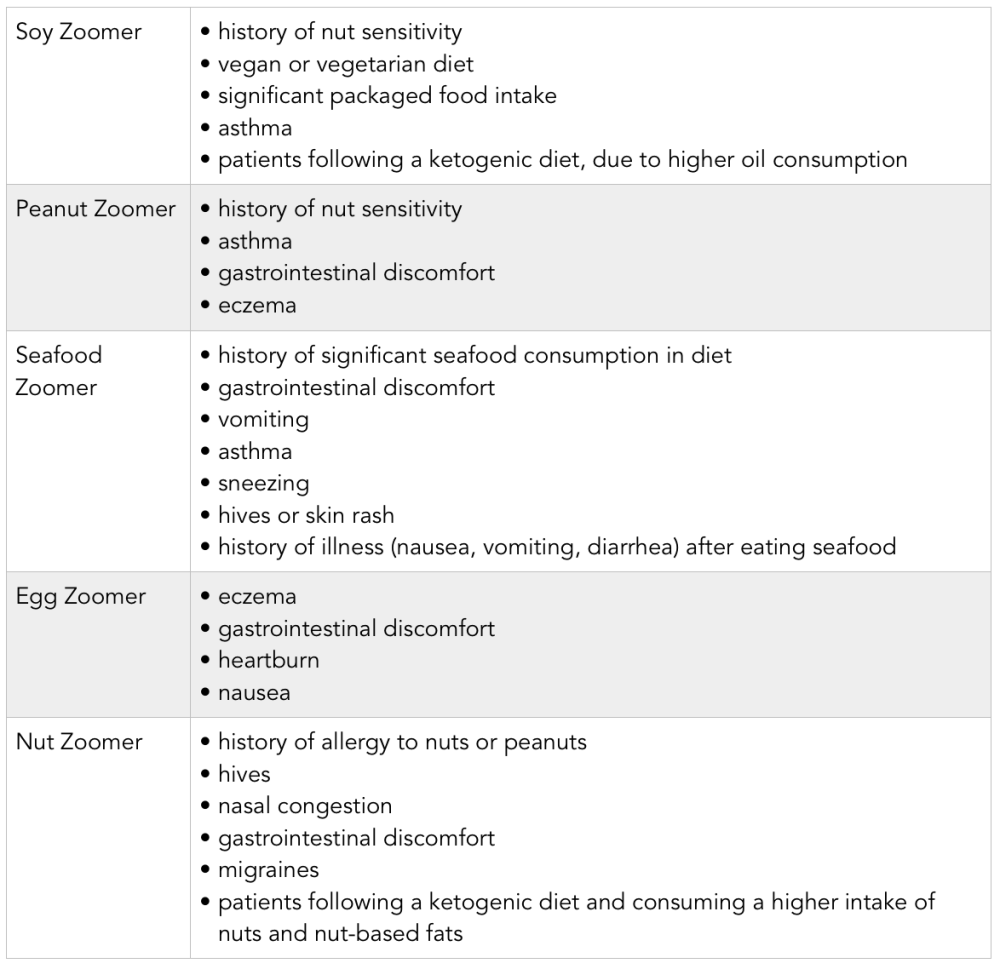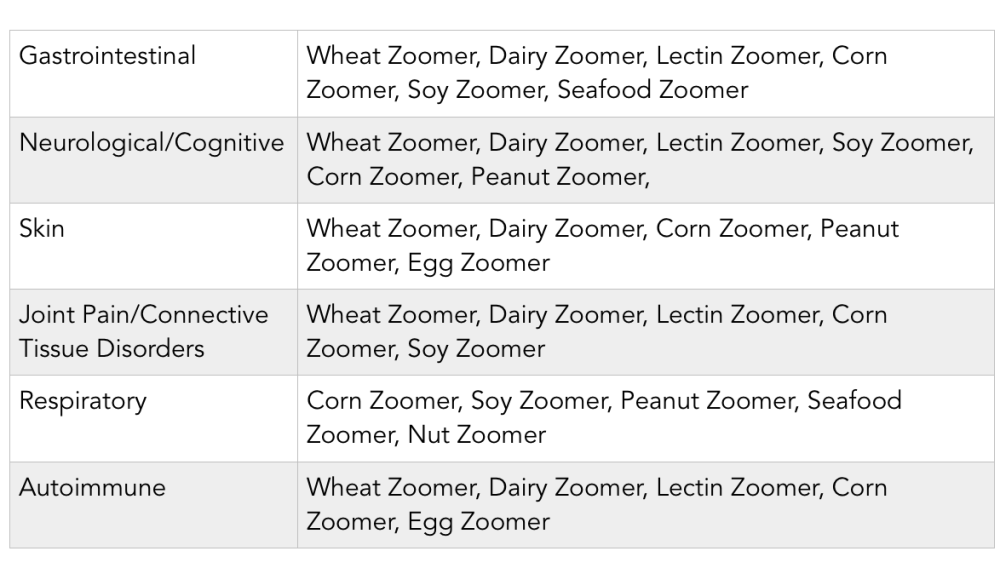How to Choose Your Food Zoomers

The Vibrant Food Zoomers provide the most in depth and accurate look at true food sensitivities – because they are tests that examine immune responses to peptides within these antigenic foods, compared to all other food sensitivity tests which measure antibodies to whole proteins, which are rarely actually what our immune systems are exposed to in real life during digestion.
Currently, the Vibrant Food Zoomer menu includes:
Wheat Zoomer: to detect sensitivity to thousands of peptides in gluten and wheat, celiac disease, intestinal permeability (“leaky gut”), and wheat allergy
Lectin Zoomer: to detect sensitivity to 17 high-lectin foods and 7 high-aquaporin foods
Corn Zoomer: to detect sensitivity to peptides in corn, including GMO and non-GMO varieties
Dairy Zoomer: to detect sensitivity to all peptides in cow’s milk
Egg Zoomer: to detect sensitivity to peptides in egg white and egg yolk
Peanut Zoomer: to detect sensitivity to all known antigenic peptides in peanut
Nut Zoomer: to detect sensitivity to multiple tree nuts
Soy Zoomer: to detect sensitivity to peptides in soy, including GMO and non-GMO soy
Seafood Zoomer: to detect sensitivity to multiple species of fish and shellfish, including parasites common to ocean fish
These tests can be bundled together at a discounted price with four or more Zoomers on the same patient on the same draw.
Which Food Zoomers Are Right For Your Patient?
This question comes often, as there are some considerations to be given to the differing diets, symptoms, environments, and medical histories of each patient you see.
General reasons for running a Food Zoomer bundle may include:
- if the patient seems especially sensitive (chemically sensitive, for example), manifesting in rashes, temperature dysregulation, coughing, running nose, watering eyes, excess sneezing after eating certain foods
- if the patient has an autoimmune disease
- if the patient is unable to heal an issue despite multiple efforts – i.e. unable to lose weight despite great efforts, still has heartburn even though they avoid spicy foods, etc.
- if the patient has altered bowel function (symptoms of IBS, SIBO, heartburn, constipation, diarrhea, excess gas/pain)
- if the patient has relentless psychological symptoms, such as panic attacks, anxiety, OCD, schizophrenia, or other serious psychological or cognitive issue (as well as PANDAs)
- if the patient has other neurological symptoms, even if they do not have gastrointestinal symptoms
Undoubtedly, the Wheat Zoomer is a foundational test and should be included in each Food Zoomer bundle being run on a patient for the first time.
The Wheat Zoomer goes far beyond just wheat and gluten sensitivity. It currently provides the most in-depth panel for assessment of intestinal permeability available, which does have a connection to gliadin in gluten-containing grains.
And, even if you assume your patient has intestinal permeability, the Wheat Zoomer can still differentiate between permeability that is likely caused by gluten and permeability that is more likely to be caused by gram negative bacteria, for instance.
Next, you should decide which foods the patient is most commonly eating that are known to be antigenic. This requires a thorough food or diet history, which should be a standard part of every functional provider’s intake forms.
Asking a patient not just what they have eaten for the last 24 hours, but what foods they eat daily, weekly, and monthly will also aid in building a pattern of how the patient eats and what foods would be most meaningful to test for sensitivity.
Some of the above foods are found frequently and abundantly throughout the food supply, and even when patients say they are not eating that food, it is highly likely they actually are, hence, a good justification for running a Food Zoomer to assess reactivity, as well as confirm its presence in their diet.
You can download our Gluten-Free Diet Adherence Questionnaire or read about it in our blog post here.
Some solid recommendations for determining which of the Food Zoomers to order are as follows:


You can also approach bundling the Food Zoomers from a disease state perspective, based on diagnoses or symptom patterns. Below are some suggested bundles of Food Zoomers based on clusters of symptoms by organ system affected:

If the patient is able to run all nine Zoomers at once, ideally that gives the best information about that patient’s individual inflammatory food triggers.
But, if you must choose between the Food Zoomers to personalize a bundle that is eight Zoomers or less, hopefully these suggestions give some guidance for when to order which of the Zoomers.




